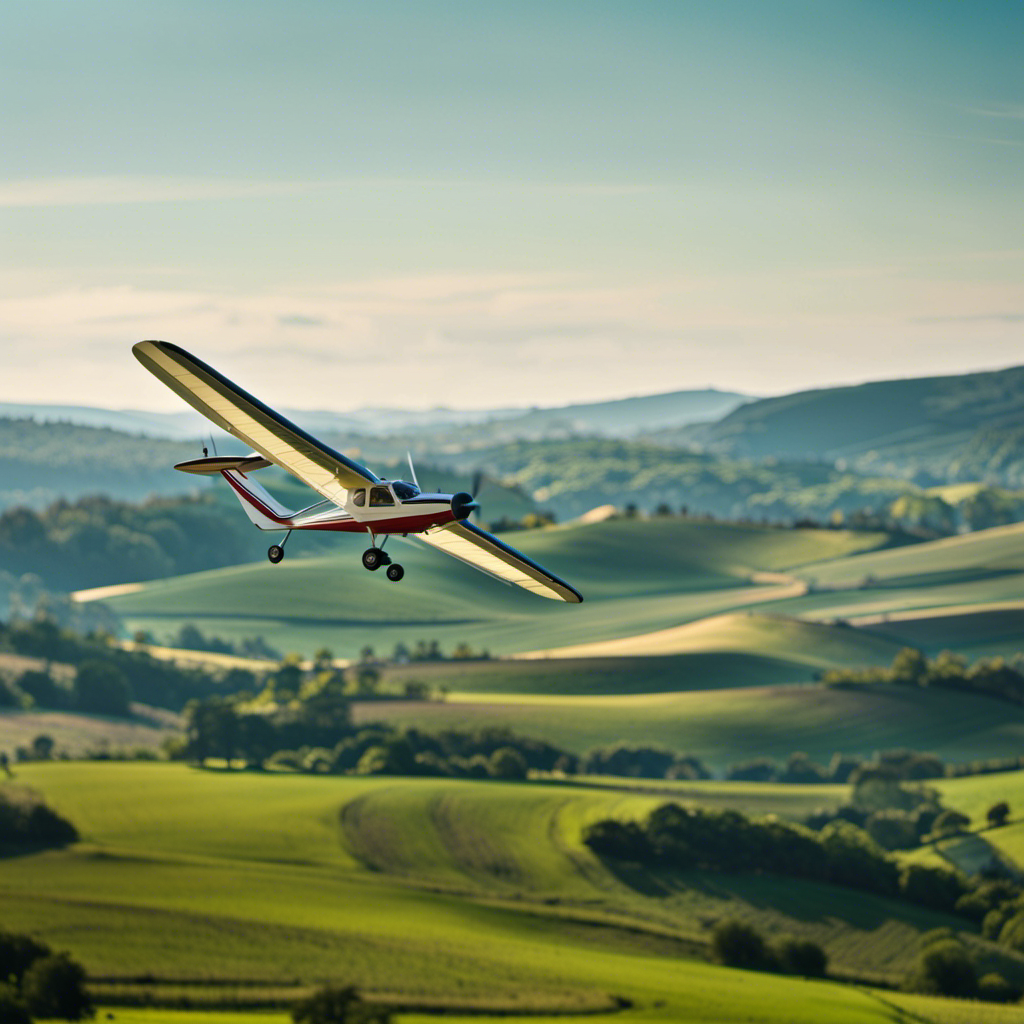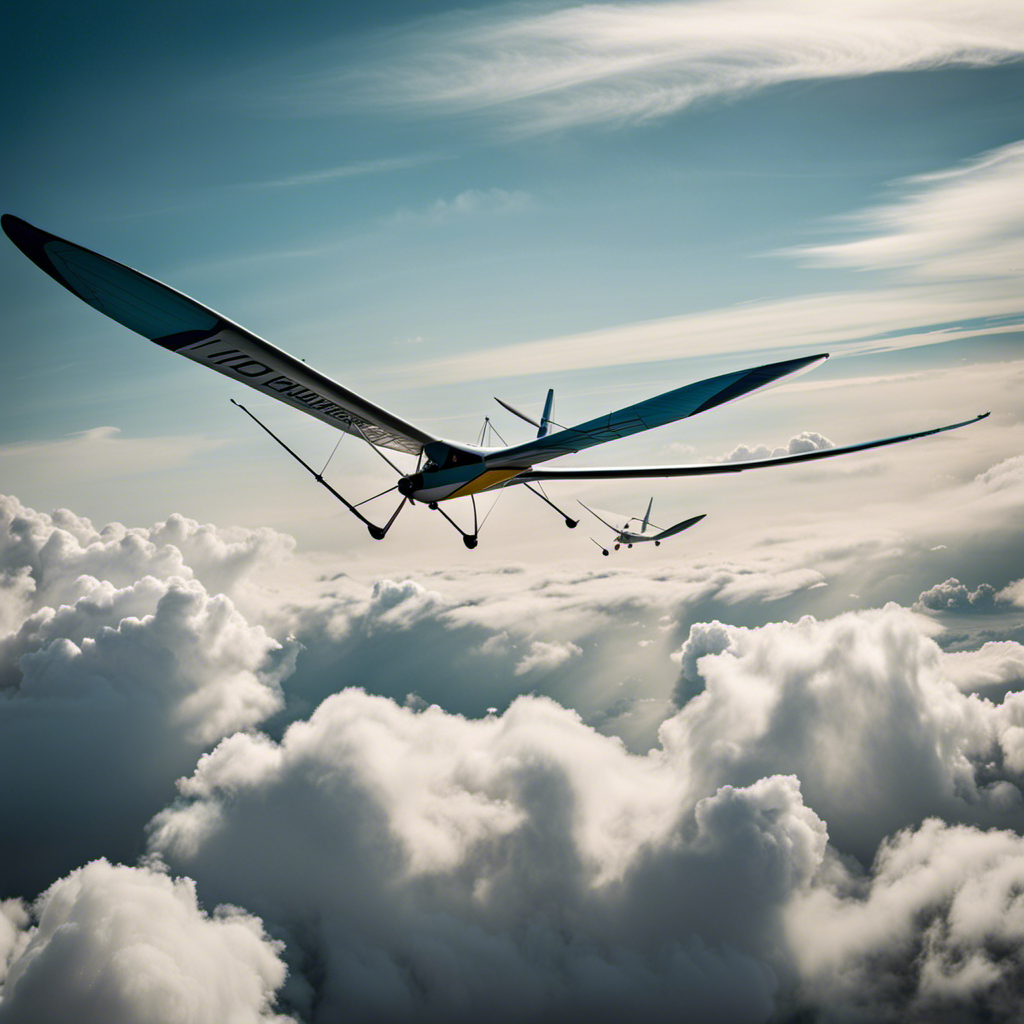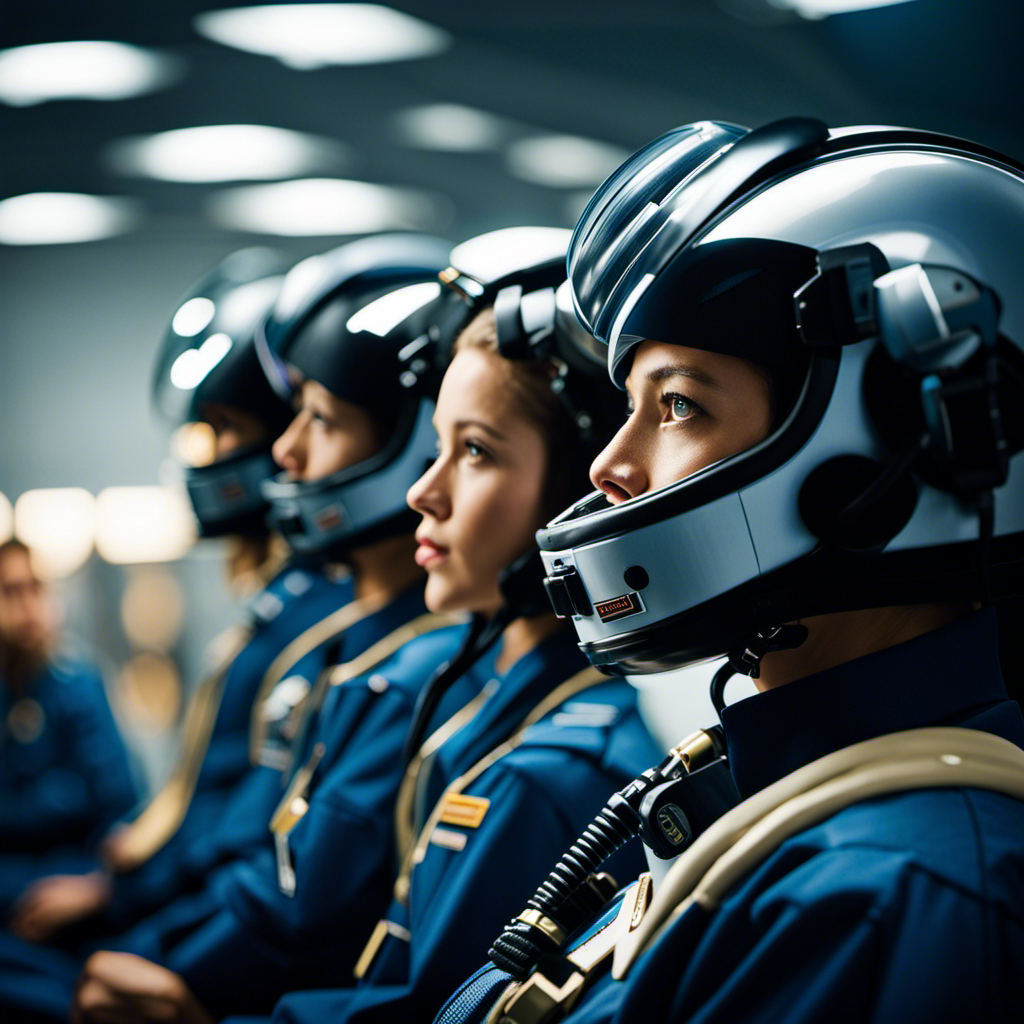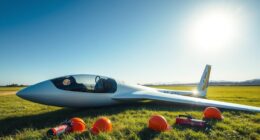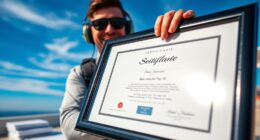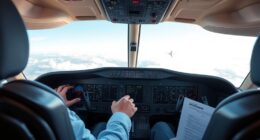As a pilot, I have always believed that the sky holds endless possibilities. However, there are specific restrictions and requirements regarding age and altitude that aspiring pilots must meet.
In this article, we’ll explore the different types of pilot licenses, the minimum age requirements, the importance of flight training at different altitudes, and the physical requirements needed to soar through the clouds.
So buckle up and get ready to embark on a journey towards achieving your pilot dreams.
Key Takeaways
- There are minimum age requirements for different pilot licenses and ratings.
- Flight training includes progressively learning to handle aircraft at different altitudes.
- Understanding the challenges and limitations of flying at high altitudes is important.
- Regular medical examinations are required to assess physical fitness for flying.
Different Types of Pilot Licenses
As a flight instructor, I am well-versed in the various licenses available to aspiring pilots. One of the most common licenses is the private pilot license, which allows individuals to fly for recreational purposes. For those looking to pursue a career in aviation, the commercial pilot license is necessary. This license enables pilots to fly for compensation or hire.
Additionally, there are specialized licenses such as the instrument rating, which allows pilots to fly in low-visibility conditions, and the flight instructor certificate, which permits pilots to teach others how to fly. Understanding the different types of licenses is crucial for anyone considering a career in aviation.
Now, let’s explore the minimum age requirements for pilot licenses.
Minimum Age Requirements for Pilot Licenses
To obtain a pilot license, you’ll need to meet the minimum age requirements set by aviation authorities. These requirements ensure that pilots have the necessary maturity and experience to safely operate an aircraft.
Here are the minimum age requirements for different types of pilot licenses:
-
Private Pilot License (PPL): The minimum age requirement for a PPL is usually 17 years old. At this age, aspiring pilots can begin their training and gain the foundational knowledge and skills needed for solo flights.
-
Commercial Pilot License (CPL): To obtain a CPL, you must be at least 18 years old. This license allows you to fly for compensation or hire, opening up opportunities for a career in aviation.
-
Airline Transport Pilot License (ATPL): The highest level of pilot license, the ATPL, requires a minimum age of 23. This license allows pilots to serve as captains or first officers on commercial airliners.
Meeting these minimum age requirements is the first step towards becoming a pilot. Once you have met the age criteria, you can then proceed to the next phase of your training, which involves learning to fly at different altitudes.
Flight Training at Different Altitudes
Once you’ve met the minimum age requirements, your flight training will involve learning to fly at various altitudes. Flight training methods are designed to teach aspiring pilots the necessary skills to navigate different altitudes safely and efficiently. Altitude restrictions play a crucial role in flight training, as they help pilots understand the challenges and limitations associated with flying at high altitudes.
During flight training, pilots are introduced to different altitude levels through a progressive approach. They start with lower altitudes and gradually progress to higher ones, allowing them to gain experience and confidence in handling the aircraft at different elevations. This step-by-step approach ensures that pilots are well-prepared to handle the unique challenges that come with flying at higher altitudes, such as thinner air and increased turbulence.
Learning to fly at various altitudes is essential for pilots to develop a comprehensive understanding of flight dynamics and to be able to adapt to different environmental conditions. As pilots gain experience and proficiency, they become better equipped to handle the complexities of flying at different altitudes.
Transitioning into the subsequent section about physical requirements for pilots, it is crucial to consider the importance of maintaining good health and physical fitness in this demanding profession.
Physical Requirements for Pilots
When pursuing a career as a pilot, it is important to understand the physical requirements necessary for the job. Physical fitness plays a crucial role in ensuring the safety and well-being of both pilots and passengers.
As pilots, we undergo regular medical examinations to assess our physical condition and ensure that we are fit to fly. These examinations evaluate factors such as vision, hearing, cardiovascular health, and overall physical fitness. It is essential to maintain a healthy lifestyle, including regular exercise and a balanced diet, to meet these requirements. By prioritizing our physical well-being, we can ensure that we are prepared to handle the demands of our profession.
With the physical requirements in mind, let’s now explore the various aviation education and training programs that aspiring pilots can undertake to fulfill their dreams.
Aviation Education and Training Programs
As an aspiring pilot, it’s crucial for you to research and explore the various aviation education and training programs available. The right program can provide you with the knowledge, skills, and qualifications needed to pursue a successful career in aviation.
Here are three key factors to consider when choosing an aviation education and training program:
-
Accreditation: Look for programs that are accredited by recognized aviation authorities. This ensures that the program meets high standards of quality and is recognized within the industry.
-
Aviation Scholarships: Explore opportunities for aviation scholarships to help fund your education. Many organizations offer scholarships specifically for aspiring pilots, providing financial support to pursue your dreams.
-
Online Pilot Training: Consider online pilot training options, which can offer flexibility in terms of scheduling and location. Online programs often include interactive simulations and virtual flight training, allowing you to gain valuable experience in a convenient and accessible way.
By carefully considering these factors, you can choose an aviation education and training program that suits your needs and sets you on the path to becoming a pilot.
Now let’s delve into the importance of flight experience and hours in the next section.
Flight Experience and Hours
After completing an aviation education and training program, the next crucial step towards becoming a pilot is gaining flight experience and accumulating the necessary pilot hours.
Flight experience refers to the practical application of the knowledge and skills acquired during training, and it plays a vital role in developing proficiency and confidence in handling different aircraft and navigating various flight scenarios.
Pilot hours, on the other hand, refer to the number of hours spent actively flying an aircraft. These hours are essential as they contribute to a pilot’s overall competency and readiness to handle different types of flights, including solo flights and more complex operations. The amount of flight experience and pilot hours required may vary depending on the type of pilot license or rating being pursued.
Now, let’s delve into the aviation regulations and licensing authorities that oversee and enforce the standards for pilots in the industry.
Aviation Regulations and Licensing Authorities
To navigate the world of aviation regulations and licensing authorities, it’s important to familiarize yourself with the specific rules and requirements set forth by these governing bodies.
Aviation regulations are the guidelines put in place to ensure safety and standardization within the industry. These regulations cover a wide range of areas, including pilot qualifications, aircraft maintenance, and air traffic control procedures.
Licensing authorities, on the other hand, are responsible for issuing and renewing licenses and certificates to pilots and other aviation professionals. They ensure that individuals meet the necessary training and experience requirements before allowing them to operate aircraft or perform specific aviation-related tasks.
Understanding and complying with these regulations and requirements is crucial for anyone looking to pursue a career in aviation. By doing so, individuals can ensure their own safety and the safety of others while enjoying the many career opportunities in aviation.
Career Opportunities in Aviation
There are various career opportunities in aviation for individuals who are interested in working in the industry. With the constant growth of the aviation sector, there is a high demand for skilled professionals, creating excellent job prospects and opportunities for career advancement. Whether you aspire to be a pilot, air traffic controller, aircraft mechanic, or aviation manager, the industry offers a diverse range of roles to suit different skill sets and interests. To help you understand the potential career paths in aviation, here is a table showcasing a few examples:
| Career | Description |
|---|---|
| Pilot | Responsible for flying and navigating aircraft |
| Air Traffic Controller | Ensures safe and efficient movement of air traffic |
| Aircraft Mechanic | Repairs and maintains aircraft |
| Aviation Manager | Oversees operations and manages resources |
Transitioning into the subsequent section about continuing education and recurrent training, it is important to stay updated with the latest industry standards and regulations.
Continuing Education and Recurrent Training
As a pilot, it’s crucial to continuously enhance our skills and knowledge through ongoing training and education.
This discussion will focus on three key areas: pilot proficiency checks, flight simulator training, and safety and emergency procedures. These topics are essential for maintaining a high level of proficiency and ensuring the safety of both the crew and passengers.
Pilot Proficiency Checks
Do you know when you have to undergo pilot proficiency checks?
As a pilot, it is crucial to regularly assess your skills and knowledge to ensure safe and efficient operations. Pilot proficiency testing is an essential part of pilot skill evaluation and is required by regulatory authorities.
Here are four important things to know about pilot proficiency checks:
-
Frequency: Pilot proficiency checks must be conducted at regular intervals, typically every six months or one year, depending on the type of aircraft and license held.
-
Content: These checks assess a pilot’s knowledge of aircraft systems, emergency procedures, and their ability to handle various flight scenarios.
-
Performance Standards: Pilots must meet specific performance standards during these checks, demonstrating their proficiency in areas such as takeoffs and landings, instrument flying, and emergency procedures.
-
Consequences: Failing a pilot proficiency check can result in additional training requirements or even the suspension of a pilot’s license.
Transitioning into the subsequent section about flight simulator training, utilizing flight simulators is an effective way to enhance pilot proficiency and prepare for these checks.
Flight Simulator Training
To enhance your pilot proficiency, utilizing flight simulators can be an effective way to prepare for and improve your skills. Flight simulators offer a range of benefits, from providing a realistic and immersive training environment to allowing pilots to practice various scenarios without the risks associated with real flight. These simulators use advanced technology to accurately replicate the experience of flying an aircraft, including realistic controls, visuals, and even motion feedback. By using a flight simulator, pilots can enhance their knowledge of aircraft systems, practice emergency procedures, and develop their decision-making skills in a safe and controlled environment. Additionally, flight simulators allow pilots to simulate challenging weather conditions, navigate through complex airspace, and practice landing at different airports. Overall, incorporating flight simulator training into your pilot proficiency checks can greatly contribute to your skill development and overall safety as a pilot.
| Flight Simulator Benefits | Flight Simulator Technology |
|---|---|
| Safe and controlled environment for practice | Advanced visuals and realistic controls |
| Ability to practice various scenarios | Motion feedback for a more immersive experience |
| Enhances knowledge of aircraft systems | Accurate replication of flying experience |
| Develops decision-making skills | Simulation of challenging weather conditions |
| Helps navigate through complex airspace | Practice landing at different airports |
With flight simulator training, pilots can improve their proficiency in various aspects of flying, from navigation to emergency procedures. Transitioning from flight simulator training to safety and emergency procedures, pilots must be well-prepared to handle any unforeseen circumstances that may arise during a flight.
Safety and Emergency Procedures
Transitioning from flight simulator training, pilots can enhance their proficiency in safety and emergency procedures to ensure they are well-prepared for any unforeseen circumstances that may arise during a flight. Safety procedures and emergency protocols are critical aspects of pilot training, as they provide the necessary knowledge and skills to handle challenging situations in the air.
Pilots must be able to swiftly react and make sound decisions when faced with emergencies such as engine failures, severe weather conditions, or cabin depressurization. By practicing these procedures in a controlled environment, pilots can develop muscle memory and increase their confidence in handling emergencies. This level of preparedness is essential for maintaining the safety of both the crew and passengers.
Transitioning to the next phase of pursuing your pilot dreams, let’s explore the requirements and qualifications necessary to become a licensed pilot.
Pursuing Your Pilot Dreams
When it comes to pursuing your pilot dreams, there are three key points to consider: setting goals and milestones, finding mentors and networking, and taking the first steps in aviation.
Setting goals and milestones is crucial in order to have a clear vision of what you want to achieve and to stay motivated throughout the journey.
Finding mentors and networking with experienced pilots can provide valuable guidance and advice, as well as open doors to new opportunities.
Setting Goals and Milestones
Start by creating specific goals and milestones for yourself in order to become a pilot at your desired age and altitude. Setting goals is crucial in any endeavor, and becoming a pilot is no exception. By defining clear objectives, you can chart your progress and stay motivated throughout your journey.
Begin by determining the age at which you aim to obtain your pilot’s license and the altitude you aspire to fly at. Break down the process into manageable milestones, such as completing flight training courses, accumulating a certain number of flight hours, and passing necessary exams. Achieving these milestones will bring you closer to your ultimate goal of becoming a pilot.
As you progress, remember to celebrate each milestone along the way. Now, let’s explore the next crucial aspect of your pilot journey: finding mentors and networking with industry professionals who can guide you towards success.
Finding Mentors and Networking
Finding mentors and networking is essential for aspiring pilots to gain valuable guidance and connections in the aviation industry.
When it comes to finding mentors, it is important to seek out experienced pilots who can provide insights and advice based on their own experiences. These mentors can offer valuable knowledge and expertise, helping aspiring pilots navigate the complexities of the aviation industry.
Additionally, networking allows aspiring pilots to expand their professional circle and create connections with people who can open doors and provide opportunities. Attending industry events, joining aviation organizations, and utilizing online platforms can all help in building a strong network.
Taking the First Steps in Aviation
Taking the first steps in aviation can be an exciting and challenging endeavor. Aspiring pilots must navigate the complex world of flight schools and pilot qualifications. It is important to choose a reputable flight school that offers comprehensive training programs. These programs should cover both theoretical knowledge and practical skills necessary for a successful career as a pilot. In terms of pilot qualifications, there are several requirements that must be met. These include a minimum age requirement, typically 16 or 17 years old for a private pilot license, and 18 years old for a commercial pilot license. Additionally, aspiring pilots must pass medical examinations to ensure they are physically fit for the demands of flying. Overall, embarking on a journey to become a pilot requires dedication, commitment, and a passion for aviation.
| Flight Schools | Pilot Qualifications |
|---|---|
| Reputable | Minimum age |
| Comprehensive | Medical examinations |
| Theoretical | Physical fitness |
| Practical | |
| Training programs |
Frequently Asked Questions
What are the medical requirements to become a pilot?
To become a pilot, you must meet specific medical requirements set by aviation authorities. These requirements ensure that you are physically fit to operate an aircraft safely. Additionally, pilot training costs can vary depending on the type of license you pursue.
Are there any height or weight restrictions for aspiring pilots?
Height and weight restrictions are crucial for aspiring pilots. These restrictions ensure that pilots can comfortably fit into the cockpit and operate aircraft safely. It is important to meet these requirements to pursue a career in aviation.
Can someone with a criminal record become a pilot?
Yes, someone with a criminal record can become a pilot. However, it depends on the severity and nature of the offense. Background checks are conducted during pilot training to evaluate eligibility.
Is there a maximum age limit to start pilot training?
There is no maximum age limit to start pilot training. As long as an individual meets the necessary physical and mental requirements, they can begin their training at any age.
What are the financial costs associated with becoming a pilot?
Financial implications of becoming a pilot can be significant. The cost of flight training, exams, and obtaining licenses can range from $60,000 to $100,000 or more. Funding options include loans, scholarships, and sponsorship programs.
Conclusion
In conclusion, navigating the skies requires more than just a dream; it demands dedication, expertise, and a deep understanding of aviation.
As I reflect on the intricate web of regulations, physical requirements, and educational programs, I am reminded of the vast expanse of knowledge that lies ahead.
Like a skilled aviator weaving through the clouds, aspiring pilots must soar above the minimum age requirements and ascend to new altitudes of learning.
With each step, the path to becoming a pilot becomes clearer, and the dream takes flight.
With a heart that soars as high as the skies, Aria, affectionately known as “Skylark,” is the driving force behind Soaring Skyways. Her journey into the gliding world began as a young dreamer gazing up at the soaring birds, yearning to experience the weightlessness and freedom they embodied. With years of experience both in the cockpit and behind the scenes, Aria’s commitment to the gliding community is unwavering.

